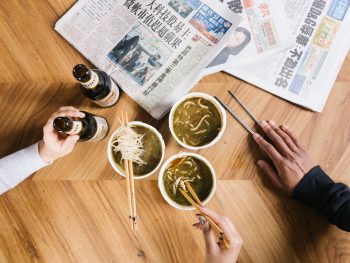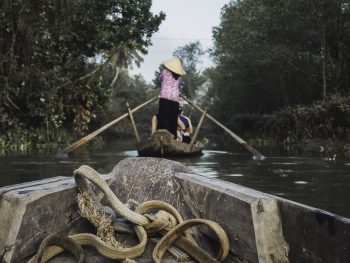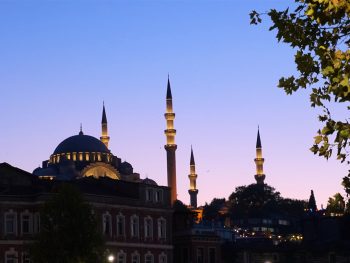Guest post by Delilah Hart
Vietnam is an amazing place to visit. From the dynamic city of Ho Chi Minh City, to the natural beauty of Halong Bay, and quaintness of Hoi An, it’s no wonder why Vietnam has become a tourist hotspot.
There are various things to grasp before your first time in Vietnam, whether it be the culture, food, or general Vietnam travel advice. Knowing these Vietnam travel tips will give you less of a culture shock, and in turn, make your trip more enjoyable.
Read on for a guide on the 10 best Vietnam travel tips.
Sort out your Visa Beforehand
Depending on where you’re from, it’s possible a visa will be required for entry into Vietnam. There is a short list of countries exempt from requiring a Vietnam visa. These visas usually allow for up to 15 days free in the country.
If you’re not exempt from the list, or if you have a free 15-day visa but are staying up to 30 days, enquire about an eVisa. This is $25 USD, sorted out completely online. My partner and I applied for an eVisa for our first time in Vietnam and the process was seamless and easy.
If your country does not offer an eVisa as an option, you’re looking for a multi-entry visa, or you’ll be in Vietnam for longer than 30 days, then you’ll need a Visa on Arrival (VOA).
The VOA process starts online. The process involves obtaining an approval letter online from a Vietnamese travel agent. This letter allows you to attain a visa when you arrive at an entry point into Vietnam. The price varies depending on how long you intend on staying in the country.
Learn How to Barter

If you’re from the western world, bartering will mostly be an unfamiliar practice to you. In Southeast Asia, haggling for your purchases is considered the norm.
It’s in your best interest to learn the tricks of the trade. Learning how to barter is one of my favourite Vietnam travel tips – it’s a lot of fun when you get the hang of it.
Exorbitant prices are offered if you ‘look like a tourist’. Prices could be inflated up to four-fold in the busiest tourist markets, such as the infamous Ben Thanh Market, one of the main attractions in Ho Chi Minh City.
A general rule of thumb is to start the bartering process at around 20 percent of the original offer. Aim to pay around 40 percent of the original offer, which gives you some wiggle room to haggle. For example, for an item where you’re given an offer of 250,000, paying a final price around 100,000 would be considered a good deal. Of course, this isn’t a be-all and end-all rule, but it’s a great place to start.
If you’re not convinced you’ve got a good price, start walking away. More often than not, the vendor will rapidly drop their prices to a fairer amount.
Outsmart Pickpockets

Vietnam is a safe country to visit but some areas, especially Ho Chi Minh City, are notorious for pickpocketers. Busy cities tend to be worse, as you’re forced to be in closer vicinity to others.
Avoiding becoming a victim of petty crime is quite simple. Vigilance is key, but also keep valuables out of sight. The saying ‘out of sight, out of mind’ really plays a key role here.
Don’t keep anything in the back pocket of your pants. If you do wear a handbag, wear it across your body instead of on your shoulder. Lock your day pack if you’re travelling through a crowded area, or wear your bag on your front to keep it in your site.
Wear Modest Clothing at Temples

When in Vietnam, the chances are you’ll be visiting some of their beautiful temples. Polite dress is encouraged, and it’s important to respect the customs of a country as a visitor. While polite dress may not be strictly enforced at every religious monument you visit, dressing inappropriately is considered rude, evoking stares from locals and tourists alike.
For females, this means you should cover your shoulders and knees. To make things easier, many people will carry around a cover-up, whether it be a sarong or scarf. Have this handy in your day pack, and you don’t have to worry about strategically choosing an outfit each morning. Some temples may also rent out coverups at a small fee, but it’s best not to rely on this.
For males, cover your shoulders, and wear either long pants or shorts that reach the knee. Many times my partner would carry around elephant pants as his cover-up, which seems to be popular amongst visitors.
Check out my five part series on a two-week cycling tour of Vietnam.
Pedal Power: A Vietnam Cycling Tour from Hanoi to Saigon
Cycling Vietnam from North to South: Hills, Hawkers, and Smiling Children
Vietnam Bicycle Tour Continues: Toilets in Vietnam
Same Same, but Different: Reaching the End of our Vietnam Cycle Tour
Learn Simple Vietnamese Phrases
Learning a language is time-consuming, but learning a few key phrases in Vietnamese will help you get further, or even just put a smile on a local’s face. The Vietnamese, especially in tourist areas have become great at English, making communication a lot easier than it would have been 20 years ago when Vietnam opened its borders to tourism.
Regardless, wherever you travel, try to learn at least hello and thank you in their national language.
In Vietnamese, hello is xin chao. This is pronounced with an ‘s’ sound, so it would be said as “sin jow”. Thank you in Vietnamese is cam on. This is pronounced as “gahm uhn”.
My favourite phrase I learned in Vietnamese before my first time in Vietnam was dat qua. This phrase is pronounced “dah kwa” and translates to ‘too expensive’. I used this phrase when bartering and it always put a smile on the vendor’s face. I’d like to think it may have opened me up to some great deals too!
Research Whether you Need Vaccinations

Like the visa situation, researching whether you need vaccinations for your first time in Vietnam is imperative. Unless you’ve travelled to Southeast Asia beforehand, it’s likely you’ll require at least one vaccination.
The most common vaccinations you may require include Hepatitis A and Typhoid. Luckily, this is administered as a single-dose combination vaccination called Vivaxim. The vaccine should be administered 14-days (or more) before your trip to Vietnam. Since your doctor may have to order the vaccination into their practice, contact your doctor at least a week prior to your intended appointment date.
Other vaccinations you may require include MMR and Japanese encephalitis, and Malaria pills.
Drink Vietnamese Coffee
Vietnam is the second-largest coffee producer in the globe.
Vietnamese coffee is amazing and I cannot stress this enough. There are two types of coffee beans; Arabica and Robusta. The form you may be most used to is Arabica, whereas, in Vietnam, you’ll find no shortage of Robusta beans.
Robusta beans are bitter, and to counteract this, sweetened condensed milk is added to the drip coffee. This creates such a delectable drink that costs a fraction of the price of an Arabica coffee. Most coffee shops will only charge 25K VND for a large iced coffee.
Cross the Street Carefully

When it comes to Vietnam’s roads, there’s a method to its madness. Traffic lights are usually non-existent, yet traffic seems to flow quite seamlessly. To first-world visitors, this organized chaos can be overwhelming when trying to cross the street in Hanoi and other large cities.
Thankfully, if you follow these Vietnam travel tips, you’ll get the hang of crossing the street in no time.
Firstly, the speed drivers go tends to be slower as they’re looking out for other motorists and pedestrians.
Secondly, drivers learn to anticipate pedestrians’ movements. If you start walking across the street they’ll anticipate where you will be when your paths cross and adjust their position on the road accordingly. But, in order for them to predict your path, keep a constant pace. If you start or stop suddenly, or begin running across the road, it’ll be harder to predict your movements.
Use Ride-Sharing Apps or Reputable Taxis
Apart from pickpocketing, another common scam involves taxis.
The first scam you may come across is the ‘broken meter’ scam. Taxis drivers will claim their meter is broken, then convince travellers to pay tourist prices for their taxi ride. If you come across a taxi driver telling you their meter is broken, just simply walk away and find another.
The second part of this tip mentions ‘reputable’ taxis. Yes, there are many, many taxi companies, but there are two who have earned a good name. Vinasun and Mai Linh are two reputable taxi companies you should use.
One scam includes companies posing as these two companies. You may see taxis labelled “Vinasum” or “Mai Lin”. Make sure you’re in the right taxi before entering. Other companies may not rip you off, but you’re far more likely to get ripped off when using other companies.
We found using ride-sharing apps (such as Grab and Gojek/GoViet) made our first time in Vietnam easy. Rates are cheaper, you can pay by card through the app on your phone, and it’ll provide the driver directions to exactly where you want to go.
Weather Differs in from the North to the South

One popular question to ask before travelling to Vietnam is “when is the best time to visit?”. Unfortunately, there isn’t a straightforward answer to that question. Vietnam spans 1600+ km from their northernmost point to their southernmost point, so the weather varies greatly depending on the location.
November to April is when Vietnam is at its driest, but the north of Vietnam can get quite cold during December and January – especially in Sapa and Ha Giang up in the mountains. For this reason, November, or February to April are the best times to visit Vietnam. Otherwise, come prepared with a waterproof rain jacket and layers. Whereas there technically is a best time to visit Vietnam, there is no wrong time to visit Vietnam! Having travelled there before during wet season, it didn’t take away from my experience at all!
Pin it for later!


Bio: Delilah Hart is a full-time traveller and writer for her travel blog, our travel mix. She is travelling throughout Southeast Asia and Vietnam is one of her favourite places in the world.














 Traveling to Myanmar: Here’s what you need to know
Traveling to Myanmar: Here’s what you need to know
Thanks for the tips Delilah, I’ve visited Vietnam 3 years ago and I think the tips that resonated most with me were checking the weather as well as learning some Vietnamese phrases. I always find it so lovely when you’re able to say and understand a few basic phrases when visiting a new country and the locals really appreciate it when you try. Thanks so much for sharing!